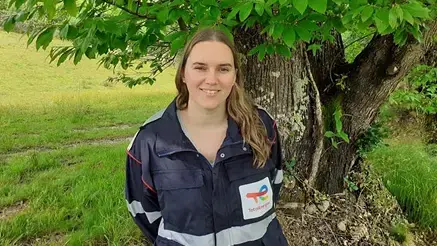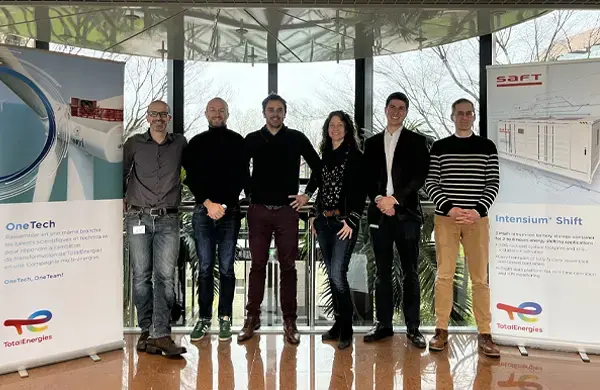From its Pau site, TotalEnergies’ engineers design solar power projects for all over the world, incorporating technological innovation, energy efficiency and biodiversity protection. Interview with Matthieu Vert-Foussats, an energy architect helping to drive this ambitious and responsible transition.
Before laying the very first stone of a solar power project, and wherever it may be in the world, a comprehensive study and development phase is required. The aim is to design solar power facilities that are technically viable, adapted to constraints in the field and economically sustainable. This phase can last for several months, or even years. At the same time, TotalEnergies conducts in-depth environmental and social impact studies on site. This work is managed by its in-house experts who listen to local communities during public consultations and apply strict standards for biodiversity protection, in line with the Company’s commitments. This means that no projects are constructed in Natura 2000 areas, and a detailed ecological inventory must be carried out on each site, to ensure that protected species are not affected. TotalEnergies has also adopted a zero deforestation policy which involves offsetting any deforestation linked to a project with equivalent or higher levels of reforestation.
Call me an Architect

Matthieu Vert-Foussats: I traveled the world for years, working on major oil and gas production sites, and spending lengthy periods abroad: Yemen, Egypt, Angola, the Netherlands, Argentina, Denmark, etc. After that, I decided to specialize in renewable energies (REs) by studying for an MBA in Renewables. I started working on the first offshore wind projects, and was given the opportunity to join the team at Pau. This still involved working in the RE sector but this time the projects were onshore, including solar panels, wind turbines and battery storage.
I’m what we call an "energy architect" at TotalEnergies, and my work combines innovation, biodiversity protection and efficiency. Just like an architect who designs houses depending on the land and budget, I design solar power projects in accordance with the technical, economic and environmental constraints. More specifically, I’m responsible for defining the size of solar facilities and issuing calls for tender for their construction, in compliance with technical and environmental constraints, to obtain the required yield. At the CSTJF in Pau, I work closely with engineers from all disciplines, specializing in energy production calculations, solar panels and wind turbines, civil engineering, operations and maintenance, as well as electricity or grid connections. My role is to coordinate all these areas of expertise.
Challenges and constraints
MVF: The first challenge is the land itself! It’s a scarce resource subject to strict regulations in certain regions. For each project, we must comply with the minimum distances from homes, airports, military radars and forests, as well as priority farming land or areas of significant ecological interest. Once these restrictions have been taken into account, we must address issues around connection to the power grid, which further limits project feasibility. Other technical constraints relate to the panels themselves. In the northern hemisphere, solar panels are generally all south-facing to better catch the sun’s rays and optimize production. Some facilities use ‘solar trackers’ that follow the sun’s path. They produce a better yield than fixed panels, but they need to be spaced wider apart and are more expensive. If they are positioned too close together, they may cast shadows in the morning or evening as they move with the sun, thus reducing the overall yield. That’s why we model several different configurations for each project: with fixed or mobile panels, spaced more or less closely together, which are either south-facing or north-facing in the southern hemisphere. The goal is always the same: to strike the right balance between energy production, economic profitability and environmental impact.
Developing projects across the globe from Pau
MVF: We oversee the development of many projects around the world. In Europe, we are present in France, Spain, Poland, Germany, the United Kingdom, Greece, among others. We have also installed solar farms in Africa, the Middle East, the USA, South America and across Asia. All these projects are managed by the CSTJF in Pau, our Headquarters in Paris, our other consultancy offices in France, and our affiliates, with flagship projects including the Ratawi project in Iraq, led by Monica Murillo, a colleague who is also an architect. This project involves the construction of a 1.2 GWp solar farm, with two million solar panels, enough to meet the electricity requirements of 100,000 households in France! It’s the first renewables project of this size in Iraq, a country that is still highly dependent on fossil fuels. The project is an integral part of the Company’s multi-energy strategy, and is set to produce its first green electrons by 2027.
The solar panels of tomorrow
MVF: Innovation is moving fast in the solar power sector. There are now bifacial modules that capture both direct sunlight and light that reflects off the ground, known as albedo. This process helps to optimize the overall yield. At the latest Intersolar Europe exhibition in Munich, the solar panels were even more efficient. Previously, we thought that the maximum yield was around 25%, but some of these modules are now closer to 30%. In other words, over the same area of land, we can produce more power. The sector is constantly progressing, which means we can look forward to more efficient and innovative panels at lower cost. Here in Pau, we are lucky enough to have an entire team of solar panel and renewables experts!

Photovoltaics: How TotalEnergies reinvents its industrial wasteland in the Béarn region
Coordinating technical and environmental studies and dialogue with all the stakeholders: Marie Landaburu coordinates the development of photovoltaics in Béarn.

Manas: a laboratory for biodiversity, large as life and twice as natural!
At Manas (64), a partnership between TotalEnergies and the CEN (French Natural Areas of Conservancy) combines biodiversity and innovation to study and protect local fauna.

Renewable energies: architects of hybrid low-carbon projects in Pau
Solar farms, wind turbines, batteries, combined-cycle power plants, etc. A new type of expertise to combine technologies and orchestrate the life cycle of projects at TotalEnergies.